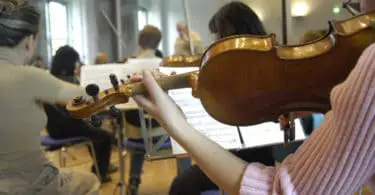Have you ever heard of the saying, “Where words fail, music speaks?” As a universal language, music connects people transcending language, age, and culture barriers. Music also plays a key role in the overall development of a child. Whether through play or on various fun activities with a melodic background, music aids in all aspects of early child development, including cognition, motor, social-emotional and language skills, self-expression, and overall literacy.
With that in mind, having a child with a natural love for melodious art is a gift for parents, especially those who recognize and value the importance of music in a kid’s development. Young as they are, a lot of children find it difficult to grasp key musical concepts such as melody, harmony, rhythm, and dynamics
The following are simple yet effective techniques to help develop a child’s musical ear:
Feeling the Beat
Keeping up with a steady beat is crucial for a child’s gross and fine motor skills development. Marching around and clapping along with nursery songs are fun ways of helping a child discover the pulse of the music. To make it more engaging, parents can integrate other interesting motions or gestures that kids can easily follow.
Loud and soft music helps the children recognize the significant difference between fast and slow beats. With loud music, children tend to sing and tap with a faster beat. Simple day-to-day activities and things that are part of our everyday lives assist kids in appreciating and following steady beats. These include heartbeat, ball bouncing, water dripping from the faucet, walking, playing on the swing, and many others.
Loving the Rhythm
Beat and rhythm go hand in hand in giving life to music. Beat is the steady pulse of the song whereas rhythm is the pattern of sound placements in specific lengths. From an academic perspective, the beat facilitates a child’s recognition of a song’s rhythm. With the skill to properly observe patterns in a song, a child develops the ability to become a keen observer and eventually transform as a productive learner.
Kids easily engage with jolly nursery rhymes, especially those that come with childish expressions such as “I like pick-le juice!” and “hamburgers and hotdogs.” This Halloween version of Hickory Dickory Dock is ideal for rhythm practice. Children with their parents can dance and clap with the song or add more silly phrases and other musical instruments into the mix to make it more fun.
Grasping Melody and Pitch
Melody is practically the one thing that can catch a listener’s attention. Nursery rhymes are practically designed with jolly melodies to keep children engaged throughout the entirety of the song. A melody is a single musical unit composed of several pitches paired with an appropriate rhythm.
Parents can give their children simple yet meaningful exposure to the highness and lowness of notes. One perfectly fun activity is the “Growing Seed” game which effectively taps the cognitive, affective, and psychomotor learning domains of a child. In this activity, the kid physically mimics a seed’s germination process by curling up on the floor like an actual seed while singing notes in ascending order.
The child gets to pose as a full-grown tree as he/she reaches the highest note. To make it more fun, the child can sing up and down the notes simultaneously while getting the appropriate pose every time. This combination of a physical activity helps deepen the child’s acquisition of the pitch concept and aids with better retention.
Let’s Sing
Singing along with fun and exciting melodies is not just about plainly enjoying the music. Experts strongly encourage parents to expose their little ones to the beauty of music through playful nursery songs to effectively aid the children’s cognitive and language development.
Kids Academy has a plethora of joyful and playful nursery rhymes for kids to sing along with on all days of the week. Songs like Ants Go Marching and 10 in the Bed are cool songs to teach children about numbers and counting. Kids can also jolly along the song If You’re Happy and You Know It while enhancing their fine motor skills and coordination. The song also encourages language improvement and word association.
Beyond learning and enjoying different sounds, singing along with kids’ nursery rhymes help in the development of their language and communication skills. The integration of music in a child’s day-to-day learning also refines other crucial aspects of a child’s early development which include social-emotional, motor, literacy, and of course, school readiness. As an art, music is an effective platform for a child’s emotional expression. For more expert parenting tips, visit the company’s Parenting Blog and overcome the challenges of helping kids excel in various aspects of their early development.








Start the discussion at talk.hearthemusicplay.com